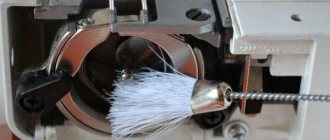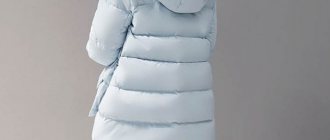We don’t keep statistics, but in Western countries it has been calculated that the average resident throws away several tens of kilograms of clothes per year. It is not always old and worn for a long time. There are many that have become deformed and shrunk due to improper care.
Partly because it is made from low-quality materials, and partly because users often do not know how to care for their clothes so that they last longer.
Each fabric has its own requirements. Therefore, you need to pay attention to the label, know what material your favorite T-shirt or sweater is made of, and how to care for such clothing.
Today there is a lot of talk about ecology and reasonable consumption. Proper care of clothes is not only a friendly gesture towards the wardrobe, but also our wallet and the planet. By properly washing, drying and storing your clothes, they will last a long time, resulting in lower costs and, as a result, less pollution.
It's important to remember that how we care for our clothes has a greater impact on the environment than we think. Few people know that:
75 - 90% of the energy used by a washing machine comes from heating the water? The lower the temperature, the lower the energy consumption.
Every year, an average of 190 kg of carbon dioxide is released into the atmosphere by people who regularly iron clothes.
Use tips to help you properly care for your clothes and reduce environmental pollution.
Good quality clothing requires proper care. You often have to spend more on it than on clothes from popular chain stores. But with proper care it will last much longer.
Conscious wardrobe management takes into account not only the clothes themselves, but also the equipment that helps take care of them, or furniture and storage accessories.
Investments in wool sweaters and silk dresses are worthless if they are destroyed by one ill-considered wash, improper drying or storage.
Why do things wear out?
The textile fibers that make up the fabric are deformed under the influence of washing, drying, high temperatures, interaction with powders, bleaches and other detergents.
Therefore, any thing has a service life and eventually breaks or loses its shape. But if you properly store, wash and iron your clothes, you can significantly extend their life. Share your clothing care tip and get a chance to win gifts: Scarlett SC-SI30K08 iron, Scarlett SC-SI30K10 iron or Scarlett SC-GS135S01 handheld steamer. To do this, click on the form below, log in using your VKontakte or Facebook profile and send your advice. The length of the text should not exceed 500 characters.
We will collect your life hacks on a special page. There you can also share tips on self-care, keeping your home tidy and eating healthy. On February 11, the editors will select the best life hacks, the authors of which will receive useful prizes from Scarlett.
# Proper drying of clothes
It would seem that there is no difficulty in drying washed clothes: hang it on a clothesline or use a drying drum in the machine. Finally, there are new generation washing machines with a dry mode. However, not all so simple. Each item has its own drying method, which is determined by the material from which the item is made.
Of course, it is best to dry clothes in the fresh air, even in winter, if, for example, you have a glazed balcony. During the summer, care should be taken to ensure that sensitive materials such as silk are not hung in direct sunlight, as this can cause stains, fiber breakdown and fading of the fabric.
Knitted items should be dried lying down so that they retain their shape. There are special drying structures for this. Taking care of your clothes is easy by following simple rules.
If clothes are dried indoors, for example in a bathroom, you need to ensure good ventilation, then a musty smell will not arise, and mold will not form on the walls over time.
The clothes dryer should be used rarely: it is harsh on both fabrics and the environment. By and large, the dryer is only suitable for towels, which soften and become fluffier in it.
How to properly store clothes
Most often, clothes become unusable due to the fact that they lose their shape: sweaters stretch, “bubbles” form on the knees of jeans and trousers, the shoulders of shirts, jackets and coats become deformed. To avoid this, you should store things correctly.
Use a hanger
Store shirts, blouses, dresses, and jackets on hangers. This way they will retain their shape longer. Fold your trousers in half and throw them over the bar; store your skirts on hangers with clothespins. Do not hang several shirts or blouses on the same hangers at once, on top of each other: this will cause them to wrinkle and lose their neat appearance.
For each item, choose suitable hangers. Their width should correspond to the width of the shoulders, otherwise “bubbles” may appear on the clothes.
Fold sweaters and cardigans
Heavy sweaters, wool and cashmere items on a hanger stretch and lose their shape, so it is better to store them on a shelf. It is also preferable to store jeans folded.
Use a pellet clipper
It happens that after one or two wears the sweater becomes covered with pills and loses its attractive appearance. It's all about the fabric: pilling is formed if it contains synthetic fibers. Even if the item is 70% wool and 30% polyester, acrylic or elastane, it will not be possible to prevent their formation. This is a natural process associated with the characteristics of the fiber. However, it is easy to get rid of the pellets using a special machine.
It runs on batteries, fits easily in your hand and will remove pellets from a sweater or cardigan in a couple of minutes, even if you are in a hurry getting ready for work or are late for an important meeting. The machine is easy to clean: remove the tank, throw out the contents and continue using it.
Use a roller to clean clothes
This is another indispensable clothing care product. The roller will not remove pellets from things, but will collect dust, small debris and pet hair.
Store clothes in covers
When putting things away for seasonal storage, use clothing covers. They are suitable for jackets, coats, items made of expensive fabrics (silk, velvet) and protect against dust, moisture and dirt.
Store shoes in transparent boxes
To store shoes, use transparent ones instead of regular cardboard boxes. They will protect shoes from dust and moisture. In addition, you will be well oriented in the closet and will easily find the right pair.
Get dressed first, then put on makeup
Try to protect your clothes from traces of decorative cosmetics. If the item is worn over the head, get dressed first and then apply makeup so as not to accidentally leave traces of makeup on the collar.
If the item has buttons, zippers, or a wide cut, put it on after you have applied your makeup. This will protect your clothes from accidental contact with cosmetics.
Don't store unnecessary things
Items you don't wear should be donated to a charity or recycled. Your closet will not be cluttered, and it will be easier to navigate your wardrobe.
How to wash clothes correctly
During washing, clothes are exposed to serious influences: high temperatures, spinning, powders and bleaches. This damages the textile fiber, and over time the item becomes unusable. To make things last longer, it is important to wash them correctly and not do it more often than necessary.
Wash only dirty clothes
If you decide to wash an item just to freshen it up, give up the idea. We wash our clothes much more often than necessary. Because of this, it wears out faster and serves us less than it could. To make your clothes look neater after wearing them, go over them with a hand steamer.
Under the influence of steam, the item will smooth out and become softer, and visually it will look as if it had been washed.
The bonus of a handheld steamer is the ease of use and speed with which you can freshen clothes and smooth out wrinkles on shirts, blouses and trousers. The steamer will not replace a regular iron (it will not be able to iron bed linen or make creases on trousers), but it does a very good job with small details, lace and appliqué. It is suitable for thin fabrics (steam will not damage delicate fabrics due to the low temperature), it can steam a jacket, coat, jacket, which a regular iron cannot do.
Another advantage of the steamer: you can use it to iron curtains and tulle, right on the curtain rod.
Prepare for washing
Before washing, check the pockets, otherwise you risk ruining both the item and the washing machine. Close all zippers to prevent them from damaging other items or scratching the drum. On the contrary, unfasten the buttons. They may fly off during washing or spinning.
Turn items inside out to prevent them from fading.
Sort things
Wash items that are similar in color together: dark with dark, light with light. Wash whites separately. Sort items by fabric type and do not wash coarse or synthetic fabrics with fine or natural ones. In addition, wash heavily soiled items separately from lightly soiled items.
Colored items may fade, so follow the care instructions on the label when washing. When in doubt, wash a small area. Is the water colored? This means the fabric is fading. This item should be washed separately at a temperature not exceeding 30 degrees.
Choose the right temperature
The number with a degree sign on the label indicates the maximum permitted washing temperature. However, this does not mean that you should wash the item at 60 degrees: the higher the temperature, the worse it is for the fabric. Therefore, if the clothes are not very dirty, wash them in colder water.
If there are stains on the item, still try to start at 30 degrees: modern powders also work at low temperatures. If the item still does not wash, switch to hotter water.
Use laundry bags
Use special bags to wash underwear, swimsuits, and tights. This will avoid hand washing, but at the same time preserve the appearance of things. Before loading your bras into the machine, fasten your bras to prevent the hooks from damaging the lace.
The bags can be used to wash items that require hand washing. Just choose the appropriate mode (delicate or hand wash) and spin at 600 rpm, no higher.
Choose the right washing powder
- Hand wash powder is not suitable for washing machines. It forms a thick foam, preventing things from moving. As a result, clothes are hardly washed and remain dirty.
- Universal powders are suitable for all types of fabric. However, powders designed for washing cotton, linen, synthetics, and wool do a better job. Therefore, it is a good idea to have several powders for different types of fabric. This way things will retain their shape and color longer.
- In addition, there are powders for washing colored and black fabrics. They keep things bright and don't let them fade.
- For washing delicate fabrics, knitwear, microfiber and lace, it is better to use liquid products with softeners. They wash in a gentle cycle and will not damage delicate fabric.
- To avoid shedding and shrinkage of the fabric, you can add a spoonful of vinegar solution.
- Powders with enzymes (protein enzymes) wash blood, milk, sauces, and ice cream well. However, you need to wash things at a temperature no higher than 50 degrees.
- Do not add more powder than necessary, otherwise there may be white streaks on things and excess detergent in the seams. In addition, powder residues can cause allergies.
Get rid of stains on clothes
- The easiest way to get rid of stains is to use a stain remover. However, before use, test the reaction of the fabric on an inconspicuous area of clothing. Soak your items after using the product, then put them in the washing machine.
- Blood stains can be removed by soaking the item in cold water.
- Ink stains can be blotted with alcohol and then machine washed.
- Sprinkle wine stains with salt before washing.
- Blot greasy stains, nail polish and lipstick marks with alcohol or nail polish remover, then soak the items before washing.
- Soak clothes with soil stains with a little vinegar before washing.
Washing white items
- Try to wash white items after wearing them two or three times. This is especially true for T-shirts, shirts, bodysuits that you wore all day.
- Wash white items separately from other clothes.
- Don't get carried away with bleach. It destroys fabric fibers and reduces the life of the item.
- Wash stains on collars and cuffs with laundry soap and leave for half an hour. Then rinse and wash the item in the washing machine.
- Baking soda will help make things whiter. Dissolve a tablespoon of soda in a glass of water, add to the powder and wash at 60 degrees.
Washing jeans
- Turn new jeans inside out and soak them in water and salt for 12 hours. This way they won't shed.
- Turn jeans inside out before washing to preserve color.
- Use a mild detergent.
- Don't wash your jeans too often; it's not necessary.
- Wash jeans at a temperature no higher than 30–40 degrees.
- Do not use a strong spin cycle in the washing machine.
- Dry your jeans horizontally or by hanging them upside down.
- You can iron jeans from the wrong side at a low temperature.
Garment care instructions: extended version
The topic is banal, simple and hackneyed, at first glance. But in practice, it does not lose its relevance, it is emotional and often even painful, both for buyers and sellers. How to take care of an item so that everyone lives happily ever after: the item itself, a satisfied buyer that the money spent was worth it, and a calmly working seller who is not distracted by customer complaints.
The first tip is the leader among the obvious, but which is most often ignored - decipher the label. We read what is written on the seller’s website, if the work is handmade and labels are not sewn in, or we ask directly. In any way we obtain information about the required care from the manufacturer, in a word. The master has already sewn dozens, or even hundreds, of such things, plus those that he has in his closet, therefore he definitely knows about care more than anyone else.
Let's say a label with care symbols is sewn into the product. The simplest search on the Internet using the words “clothing care” will help you decipher the symbols, or, as we wrote at the Fair - . And the very first symbol is the most important. It says hand wash, which means pour water into a basin and wash it by hand. Is it possible to put the machine in hand wash mode? If you want, check with the seller and do as he says. And not the other way around, we’ll do it, and then ask why the village faded, and so on.
My personal pain is more subtle. I write everywhere that it is machine washable! Machine only! At 30 degrees on delicate mode. But clients continue to come to me who pour water into a basin, spoil things and then ask what they did wrong, because they chose the most delicate of all possible methods of caring for the thing. Something went wrong? Of course, it's machine washable! Machine only! When pouring water into a basin, do you check its temperature with a thermometer? Hardly. Just for the sake of experiment, try holding your hands for 15 minutes in 30-degree water. It's cold, isn't it? It even brings you down. And then the skin peels off. So, no one, almost no one, washes by hand at 30 degrees. Therefore, if the first rule in the care instructions is machine washable, then you need to machine wash it. The machine will not pour warm water, it is responsible and disciplined. And for fabrics, plus 5 degrees can be absolutely critical. A little warmer water - and the viscose has already shrunk, the dye has flowed. I had a case. I took the sewn blouse sample for myself and went on vacation with it. There, to be honest, I washed it with anything and without following any regime, but strictly in cold water, since I was on vacation, rented housing, and had no time for nuances. In the end, everything is fine with the blouse. The viscose did not shrink, the blue flowers did not flow onto the light background. Upon arrival, I received a letter from a client who bought the same blouse, saying that the fabric was bad and faded. Well, yes, they washed it by hand, because what could be better? I now have two blouses hanging on the hanger, one faded and one not. One piece of fabric, everything is the same in the blouses. After this incident, I definitely confirmed my opinion about hand washing. As for fabrics of black, blue, red colors, they always shed, even the most expensive and high-quality ones, just to a greater or lesser extent. Do they still wash black clothes separately from white ones? That’s why, even when you wash it not for the second or tenth time. Just wash your new red dress once or twice separately from other items, and then it is better to wash it with items of a similar shade. This rule works great over the long haul. My mother divides things by color very strictly; for her, gray will be washed separately from beige, and red from orange. I am more careless in this regard. If you compare the quality of my mother’s clothes in the closet and mine, the advantage of her approach to washing will be obvious.
Why else is the mode for delicate fabrics (wool/silk) often the optimal means for caring for things? Why you shouldn’t wash on the cotton cycle is probably clear to everyone. Why, again, not pour water into the basin? Well, how do you wash it by hand: soak it, soap it, squeeze it, especially carefully in dirty places. But the machine doesn’t do this, therefore it doesn’t deform the fabric fibers, the item peels less and lives in your closet longer. And spinning on the delicate mode is very gentle and does not twist the fabric fibers. To make washing even more gentle, put one item or literally several in the machine. Then your silk blouse will not get caught in the zipper of your skirt. It’s scary to remember how many things were ruined by bra hooks at one time, because both of them seem to be delicate. If the item has buttons, be sure to fasten them. The same rule applies to lightning. And preferably turn the item inside out. Let's trust modern technology! Technological progress is unstoppable, and gloriously so. With all the love for naturalness and naturalness, the machine spends less water and electricity and treats things more carefully, and most importantly, the human factor with its mistakes is eliminated! I, of course, will not argue with alternative recommendations for caring for things that other sellers indicate, but my experience shows that washing any item on a delicate cycle, in cold water, you will get a consistently good result. This is how I take care of underwear, tights, woolen knitwear, etc. True, I don’t have much experience with natural silk and cashmere, so I can’t give you any advice. But wool, cotton, linen, and viscose are great for such care.
After washing, it's time to dry. Delicate items will thank you more if they are dried flat, especially knitwear. To keep this rule from being too much of a hassle, I place items directly on the dryer, often on top of others that are drying vertically, and it becomes quite easy. With the rest, including silk and wool, I don’t bother so much. If you shake each item well before hanging it on the dryer, it will be much easier to iron, and some will not need ironing at all. I thought everyone knew about this, but no, I still can’t stop my husband from hanging wet lumps of clothes on the dryer.
It is better to iron any fabric slightly damp. Although only linen should be raw, otherwise you simply won’t iron it. But it is important that any things are not overdried. We washed it in the evening, hung it to dry, ironed it in the morning and hung it in the closet. If an item hangs on the dryer for a week, you won’t be able to iron it that well and you won’t get such a fresh and expensive look, even if the item is high-quality and new. Even if you are ironing a still damp item, turn on the maximum steam on the iron, this will iron it much better. People often write to me that things arrive perfectly ironed - this is all thanks to steam, which is very powerful on industrial equipment. The iron, in my opinion, is the main element of your image. I think he will compete for the right to primacy with clean shoes and good face cream. If possible, buy steam generators, and if you can buy a small semi-professional one, it will be even better. This item will make your clothes look much more expensive than the amount you paid for them. And if you really get sick of this topic, you can buy one or two ironing pads. And no one around you will look the way you look. But about ironing, however, you can write a whole separate article. Often we cannot get enough of a new thing, but after we wash it, we like it much less. This is precisely because we cannot iron it properly. When a thing is sewn, it is ironed after each operation, each line, which we cannot do after washing. But it is possible to get closer to this result. I’ve been thinking for a long time about writing a master class (or is everyone already taking them off?) about ironing some complex shirt or dress. I have never seen a single person without specialized sewing education who could really iron a garment with high quality. Well, why not, and sewing workers don’t consider this whole thing necessary. Will the information be useful? Well, one more thing about ironing. If you washed it according to the recommendations, but it seems that the item has shrunk, iron it. Wrinkled, wrinkled items appear and feel smaller, and an iron solves this problem. This is always the case with viscose, and it often happens with cotton. Well, a couple of tips before washing. Don't overstuff things. Even if your white blouse looks fine after a day at the office, throw it in the wash. If you do this after every wear, the item will still be fresh a year later. If you wait until marks appear on the collar and cuffs, there is a high probability that the item will not return to its previous appearance. And then the desire arises to make the water hotter, set the mode to a more active one, and manually wash it thoroughly, “squeeze it.” Well, if it doesn’t fade or shrink, then the fabric will simply lose its appearance much faster. And it’s also good to give things a rest, not to wear the same thing all the time. It sounds somehow mystical, but in fact, five blouses together will last you longer than five sequentially, and they will look good for the entire service life. Thank you very much for your attention! I wrote this article as a reminder for my clients, but I hope that it will be interesting to everyone. If you have any life hacks of your own on this topic, please share them in the comments.
How to iron things correctly
Ironing things is a labor-intensive process that takes a lot of time. Nevertheless, ironed items look more neat and tidy and absorb dirt and sweat less well. Therefore, you shouldn’t give up ironing. To make the process easier, more enjoyable and faster, use a good iron with continuous steam, burst of steam and spray function. They will help you quickly deal with wrinkles. And the anti-scale protection and self-cleaning function will protect your clothes from stains and marks.
However, it is worth following the ironing rules: temperature conditions, sequence and other recommendations. Some fabrics are better not to iron at all (you should use a steamer instead).
Read the information on the label
Different fabrics require a certain temperature treatment and level of moisture. Therefore, be sure to read the information on the label and follow the recommendations provided.
- Crossed-out iron sign: the item cannot be ironed or steamed.
- A crossed out iron with two lines at the bottom: the item can be ironed, but cannot be steamed.
- A regular iron icon with two lines at the bottom: you can steam the item, but you cannot iron it.
- Iron icon without lines: you can iron and steam the item.
- The dots in the iron indicate the maximum allowed ironing temperature. One point - you can iron at temperatures up to 100 degrees, two points - up to 150 degrees, three - up to 200 degrees.
Do not iron dry fabric
It is much easier to remove wrinkles if the item is slightly damp. Therefore, dampen wrinkled items or use the steam function on the iron. Water will significantly speed up and simplify the process.
Start ironing at low temperature
The iron heats up faster than it cools down. To save time and avoid damaging delicate fabrics, start ironing with them (silk, polyester, acrylic). After ironing thin fabrics, move on to cotton and linen.
How to iron different types of fabrics
- Synthetic fabrics can be ironed with a warm iron using damp gauze.
- To iron a silk item, it is better to use a hand steamer. The steam temperature will not spoil the product, and you will quickly complete the task. If you iron a silk item, first dampen it and iron on low heat. Do not spray the fabric while ironing, otherwise dripping marks may remain on the fabric. Iron dark silk through gauze from the wrong side, light silk from the front.
- Woolen items can be left unironed or ironed at a low temperature using a damp cloth. Be careful: if the iron is overheated, the item may shrink. If your wool item shrinks during washing, dampen it before ironing and stretch it to the desired size.
- Nylon is not ironed. After washing, gently smooth out the wrinkles with water.
- Do not wet viscose items and iron them dry.
- Iron velvet and plush from the inside out.
- Fabrics with long pile, camel hair, velor, soft drape should be ironed with steam from the wrong side.
- Knitwear can be ironed with a hot iron (up to 200 degrees), sequentially applying it to the fabric. You should be careful as knitwear can stretch easily.
- Linen must be ironed damp from the reverse side at a temperature of 180–230 degrees. Use steam to make ironing easier.
How to iron a shirt
The easiest way to iron a shirt is with a hand steamer. No special skills are required for this: pour in water, release steam and direct it to the item. Start with small details, then move on to larger ones.
If you iron your shirt, moisten it with a spray bottle or using a spray bottle on the iron. Start with the collar, straightening and ironing it first from the inside and then from the outside. Then move on to the cuffs. Unfasten and straighten them on the ironing board. Use steam to make it easier. Then iron the sleeves, hems and back.
How to iron a dress and skirt
The dress and skirt can be ironed using either a hand steamer or an iron. Start at the top (neckline, collar, shoulders), then move to the hem.
For the skirt, first work on the pockets and waistband, then the seams and zipper, then the main part of the product.
How to iron trousers
- Start ironing from the inside out. Press all seams, lining and pockets.
- Turn the trousers right side out and smooth the top of the item and the waistband through damp gauze, moving and pressing the iron.
- Fold the pants so that the side and inside seams match. Iron the inside of the legs first, then the outside.
- Iron the arrows.
Useful tips
- Do not iron stained clothes. Such contaminants will subsequently be difficult to remove.
- To keep ironed items in shape longer, hang them on hangers and let them cool. After this, you can put your clothes in the closet.
- If you don’t know at what temperature to iron an item, try ironing it on a small area of fabric from the wrong side.
- To remove “bubbles” from the knees of trousers or jeans, dampen an area of fabric, cover it with a piece of linen and iron it using a very hot iron. The process must begin from the edge of the site, moving towards the center.
- To make things less wrinkled in a suitcase or travel bag, roll them.
To special things - a special approach
Some things require special care. We are talking about products made of leather and fur, silk and wool. The technology for caring for them has its own specifics.
- Leather and suede clothing
Immediately after purchasing a suede product, you need to treat it with a vacuum cleaner, since industrial dust accumulates on this material. Subsequently, the suede is cleaned with a special brush or a piece of rubberized cloth without using any cleaning agent. The exception is fresh greasy stains, which can be removed with tooth powder.
We recommend: How to make jeans smaller? Washing and other shrinkage methods
Leather products are wiped with a cloth soaked in a soapy solution with ammonia, and then with castor oil or Vaseline. Another option for cleaning leather clothes and making them shine is to wipe them with a mixture of milk and turpentine (in a one-to-one ratio). It is not forbidden to use purchased funds.
It is not advisable to store suede and leather clothes in plastic covers; it is preferable to purchase or sew fabric ones for them (ideally, linen or cotton).
There is no need to fold or throw things made of leather and suede over the crossbar, otherwise creases will form that will be difficult to smooth out.
Leather items cannot be ironed; suede items can most often be ironed, but only from the inside out through a layer of thin cotton fabric.
Leather and suede clothes should not be dried near heating devices or in the sun. Dry them only at room temperature.
- Sheepskin coat and fur products
It is recommended to comb fur items regularly using a wide-toothed hair comb, and this should be done carefully. Furs can be stored folded, wrapped in light, preferably completely white, fabric made from natural materials. It should be borne in mind that fur easily absorbs any foreign odors.
It is best to entrust cleaning a fur coat or sheepskin coat to professionals, but you can try to do it at home using folk remedies.
The sheepskin coat is cleaned in two stages. The first involves treating the product with a soap solution with the addition of ammonia. The second stage is treatment with a mixture of glycerin (a tablespoon), ammonia (a tablespoon) and borax (a teaspoon) dissolved in water (two glasses).
Stains on a fur collar can be treated with boiled potatoes, wait for them to dry, and carefully comb them out. This method is suitable for products with short pile. Long fur is cleaned with talc, which is sometimes mixed with gasoline. To clean items made from light sheepskin, you can use milk by dissolving ammonia in it (5 ml per glass of milk). Light fur, if it is artificial, can be treated with water acidified with lemon juice.
- Silk and wool
Silk and wool items require delicate handling. Silk can be washed manually or in an automatic machine in a special mode. The temperature cannot be set above 40 degrees. In this case, it is mandatory to use a special product designed for washing delicate fabrics and conditioner. The drying mode cannot be used - silk clothes are dried on hangers at room temperature. Hangers need to be rubberized or with a special anti-slip coating, otherwise things will slide off them. If you don’t have them, you can improve the usual ones by gluing small pieces of rubber on them.
We recommend: How to properly clean a coat at home?
The rules for washing woolen clothes are similar. You need to dry it by turning it inside out, laying it out on a horizontal surface and straightening it well. This is necessary so that woolen items retain their shape.
Lifehacker and Scarlett give prizes for the best tips
We remind you about the promotion of Lifehacker and Scarlett. Share your advice and get a chance to win cool gifts: Scarlett SC-SI30K08 iron, Scarlett SC-SI30K10 iron or Scarlett SC-GS135S01 handheld steamer.
The conditions are simple:
- Click on the form at the beginning of the text and log in using your VKontakte or Facebook profile.
- Send us your advice. The length of the text should not exceed 500 characters.
We will collect your life hacks on a special page. There you can also share tips on self-care, keeping your home tidy and eating healthy. On February 11, the editors will select the best life hacks, the authors of which will receive useful prizes from Scarlett.











